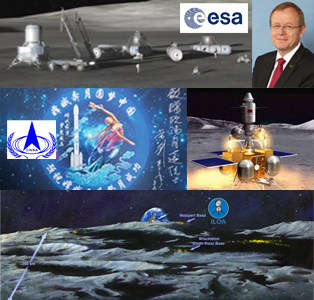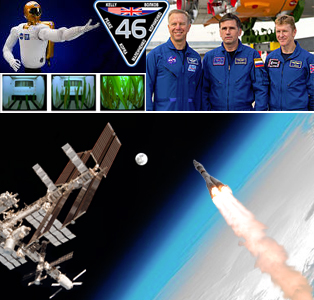International Human and Robotic Moon Missions 2015-2030: China Chang’e-3 Lander, ESA / ESTEC Symposium
As the only operational mission on the lunar surface China Chang’e-3 spacecraft continues to carry the torch for Moon Explorers around the world. Many more missions are on the way and in the next 15 years we should see permanent robotic villages begin to spring up and bear witness to the return of humans to the surface and eventual development of sustainable crewed habitats. CE5 sample return is planned to launch 2017 with 2 backup craft on deck: CE4 far side mission in collaboration with Europe, others in 2018 and CE6 sample return by 2020. It is widely expected that China will integrate the Shenzhou / Tiangong human spaceflight program to manifest Human missions to the Moon in the 2020s. In Europe ESA’s Estrack network and flight dynamics team provided critical support to CE3 during the 5-day lunar cruise, descent and after landing. ESA Director General Johann-Dietrich Wörner is extremely enthusiastic and more ambitious about Moon exploration than perhaps any of his predecessors, speaking of a “Moon village”. On Dec 15-16 ESA/ESTEC in Noordwijk, Netherlands is hosting the 1st International Symposium On Moon 2020-2030: A New Era Of Coordinated Human and Robotic Exploration with a program chaired by Bernhard Hufenbach and James Carpenter. Elsewhere: Japan is planning SLIM Lander 2018-19 & SELENE-2 in 2019; Russia hopes for Luna-25 to Moon South Pole in 2018; South Korea lander / rover on track for 2020; Lunar Mission One out of UK is projecting a lander for 2024; Golden Spike Co. led by Alan Stern developing commercial Human Moon Missions for 2020; Bigelow Aerospace is developing inflatable habitats for lunar surface stations. (Image Credit: ESA, ESTEC, CNSA, ILOA) |
MONDAY
|

![]() = All times
= All times
for terrestrial events in local time unless noted.
![]() = All times for international terrestrial events in local time unless noted.
= All times for international terrestrial events in local time unless noted.
![]() = All times for space events, and…
= All times for space events, and…
![]() = All times for international space / astro events in Hawaii Standard Time unless noted. Add 10 hours to obtain UT (‘Universal Time;’ Greenwich, England).
= All times for international space / astro events in Hawaii Standard Time unless noted. Add 10 hours to obtain UT (‘Universal Time;’ Greenwich, England).
Weekly Planet Watch – Evening Planets: Mercury (SW), Uranus (S), Neptune (S); Morning Planets: Venus (SE), Mars (SE), Jupiter (SE), Saturn (S).
Launch of ISS Expedition 46/47 with UK Astronaut Tim Peake, Tim Kopra, Yuri Malenchenko
|
Continued from…
TUESDAY
|
![]() Dec 15 — ISRO, Bengaluru, India: Proposals Due for India researchers or organizations to work with Data From Chandrayaan-1 Terrain Mapping Camera (TMC) & Hyperspectral Imager (HySI): finalists May Be Announced Dec 31.
Dec 15 — ISRO, Bengaluru, India: Proposals Due for India researchers or organizations to work with Data From Chandrayaan-1 Terrain Mapping Camera (TMC) & Hyperspectral Imager (HySI): finalists May Be Announced Dec 31.
![]() Dec 15 — SETI Institute, Mountain View CA: Lecture: High Temperature Volcanism on Earth: Physical Volcanology, Mineralogy, and Geochemistry of Archean Komatiites; presented by Michael Lesher of Laurentian University, Sudbury.
Dec 15 — SETI Institute, Mountain View CA: Lecture: High Temperature Volcanism on Earth: Physical Volcanology, Mineralogy, and Geochemistry of Archean Komatiites; presented by Michael Lesher of Laurentian University, Sudbury.
![]() Dec 15 — The National Academies, Washington DC: NASA Science Mission Extensions: Scientific Value, Policies, and Review Process.
Dec 15 — The National Academies, Washington DC: NASA Science Mission Extensions: Scientific Value, Policies, and Review Process.
![]() Dec 15-16 — ESA/ESTEC, Noordwijk, Netherlands: 1st International Symposium On Moon 2020-2030: A New Era Of Coordinated Human and Robotic Exploration.
Dec 15-16 — ESA/ESTEC, Noordwijk, Netherlands: 1st International Symposium On Moon 2020-2030: A New Era Of Coordinated Human and Robotic Exploration.
![]() Dec 15-17 — NRAO, Associated Universities, Kavli Foundation, Chicago IL: U.S. Radio/Millimeter/Submillimeter Science Futures in the 2020s; at Hyatt Regency O’Hare.
Dec 15-17 — NRAO, Associated Universities, Kavli Foundation, Chicago IL: U.S. Radio/Millimeter/Submillimeter Science Futures in the 2020s; at Hyatt Regency O’Hare.
![]() Dec 15-17 — Applied Technology Institute, Columbia MD: Space Mission Analysis and Design course; with instructor Edward L. Keith.
Dec 15-17 — Applied Technology Institute, Columbia MD: Space Mission Analysis and Design course; with instructor Edward L. Keith.
![]() Dec 15-20 — Pacifichem, Australian Peptide Association, Brunei Darussalam Institute of Chemistry, Canadian Society for Chemical Engineering, Hong Kong Chemical Society, et al, Honolulu HI: International Chemical Congress of Pacific Basin Societies.
Dec 15-20 — Pacifichem, Australian Peptide Association, Brunei Darussalam Institute of Chemistry, Canadian Society for Chemical Engineering, Hong Kong Chemical Society, et al, Honolulu HI: International Chemical Congress of Pacific Basin Societies.
![]() Dec 15 — Apollo Asteroid 2015 XN55: Near-Earth flyby (0.006 AU).
Dec 15 — Apollo Asteroid 2015 XN55: Near-Earth flyby (0.006 AU).
WEDNESDAY
![]() Dec 16 — ISRO, Launch PSLV / TeLEOS 1, Satish Dhawan Space Center, Sriharikota, India: India Polar Satellite Launch Vehicle, flying on PSLV-C29 mission in PSLV-CA configuration, to launch TeLEOS 1 Earth observation satellite & 5 smaller satellites for Singapore.
Dec 16 — ISRO, Launch PSLV / TeLEOS 1, Satish Dhawan Space Center, Sriharikota, India: India Polar Satellite Launch Vehicle, flying on PSLV-C29 mission in PSLV-CA configuration, to launch TeLEOS 1 Earth observation satellite & 5 smaller satellites for Singapore.
![]() Dec 16 — The National Academies, Online / Washington DC: Teleconference: Review of Progress Toward the Decadal Survey Vision in New Worlds, New Horizons in Astronomy and Astrophysics.
Dec 16 — The National Academies, Online / Washington DC: Teleconference: Review of Progress Toward the Decadal Survey Vision in New Worlds, New Horizons in Astronomy and Astrophysics.
![]() Dec 16 — Moon: 2.7° NW of Neptune, 19:00.
Dec 16 — Moon: 2.7° NW of Neptune, 19:00.
THURSDAY
![]() Dec 17 — Arianespace, Launch Soyuz / Galileo 11 & 12, Kourou, French Guiana: Arianespace Soyuz rocket, designated VS13, to launch two Galileo satellites for Europe’s Galileo navigation constellation.
Dec 17 — Arianespace, Launch Soyuz / Galileo 11 & 12, Kourou, French Guiana: Arianespace Soyuz rocket, designated VS13, to launch two Galileo satellites for Europe’s Galileo navigation constellation.
![]() Dec 17 — NASA, Orbital ATK, Mid-Atlantic Regional Spaceport (MARS), Wallops Flight Facility VA: Media tour focusing on 2016 commercial cargo resupply missions to ISS; featuring Bill Wrobel (Wallops Director), Dale Nash (Virginia Commercial Space Flight Authority), Mike Pinkston (Orbital ATK).
Dec 17 — NASA, Orbital ATK, Mid-Atlantic Regional Spaceport (MARS), Wallops Flight Facility VA: Media tour focusing on 2016 commercial cargo resupply missions to ISS; featuring Bill Wrobel (Wallops Director), Dale Nash (Virginia Commercial Space Flight Authority), Mike Pinkston (Orbital ATK).
![]() Dec 17-18 — The National Academies, Washington DC: Meeting: The Science of Science Communication: A Research Agenda.
Dec 17-18 — The National Academies, Washington DC: Meeting: The Science of Science Communication: A Research Agenda.
FRIDAY
![]() Dec 18 — ‘Imiloa Astronomy Center, University of Hawaii at Hilo, Hilo HI: Mauna Kea Skies Talk: Mapping the Milky Way without Leaving Earth; presented by Nicolas Chene of Gemini Observatory, 19:00.
Dec 18 — ‘Imiloa Astronomy Center, University of Hawaii at Hilo, Hilo HI: Mauna Kea Skies Talk: Mapping the Milky Way without Leaving Earth; presented by Nicolas Chene of Gemini Observatory, 19:00.
![]() Dec 18 — The Space Show, Online / Tiburon CA: Secure World Foundation webinar.
Dec 18 — The Space Show, Online / Tiburon CA: Secure World Foundation webinar.
![]() Dec 18-19 — University of Lisbon – Instituto Superior Técnico (IST), Lisbon, Portugal: Conference: General Relativity 100 Years in Lisbon.
Dec 18-19 — University of Lisbon – Instituto Superior Técnico (IST), Lisbon, Portugal: Conference: General Relativity 100 Years in Lisbon.
![]() Dec 18 — Moon: At first quarter, 05:14.
Dec 18 — Moon: At first quarter, 05:14.
![]() Dec 18 — Apollo Asteroid 2015 MW53: Near-Earth flyby (0.046 AU).
Dec 18 — Apollo Asteroid 2015 MW53: Near-Earth flyby (0.046 AU).
SATURDAY
![]() Dec 19 — Gaia, LEO: ESA spacecraft enters 3rd year in orbit today; 5-year planned mission aims to map more than 1 billion stars; launched in 2013.
Dec 19 — Gaia, LEO: ESA spacecraft enters 3rd year in orbit today; 5-year planned mission aims to map more than 1 billion stars; launched in 2013.
![]() Dec 19 — Cassini, Saturn Orbit: Flyby of Aegaeon (3,000 km), Enceladus (4,999 km), Calypso (92,000 km) planned for today.
Dec 19 — Cassini, Saturn Orbit: Flyby of Aegaeon (3,000 km), Enceladus (4,999 km), Calypso (92,000 km) planned for today.
![]() Dec 19 — RSA, Launch Proton / Express AMU1, Baikonur Cosmodrome, Kazakhstan: Russia government Proton rocket to launch Express AMU1 communications satellite for Russian Satellite Communications Co.
Dec 19 — RSA, Launch Proton / Express AMU1, Baikonur Cosmodrome, Kazakhstan: Russia government Proton rocket to launch Express AMU1 communications satellite for Russian Satellite Communications Co.
![]() Dec 19 — SpaceX, Launch Falcon 9 / Orbcomm OG2, Cape Canaveral AFS FL: SpaceX to launch 11 OG2 satellites for communications company Orbcomm.
Dec 19 — SpaceX, Launch Falcon 9 / Orbcomm OG2, Cape Canaveral AFS FL: SpaceX to launch 11 OG2 satellites for communications company Orbcomm.
![]() Dec 19 — Griffith Observatory, Los Angeles CA: Griffith Observatory Star Party; free public event, 14:00-21:45.
Dec 19 — Griffith Observatory, Los Angeles CA: Griffith Observatory Star Party; free public event, 14:00-21:45.
![]() Dec 19 — Moon: 3.8° S of Pluto, 11:00; 1.1° SSE of Uranus, 15:00.
Dec 19 — Moon: 3.8° S of Pluto, 11:00; 1.1° SSE of Uranus, 15:00.
![]() Dec 19 — Apollo Asteroid 2015 XE1: Near-Earth flyby (0.034 AU).
Dec 19 — Apollo Asteroid 2015 XE1: Near-Earth flyby (0.034 AU).
![]() Dec 19 — Amor Asteroid 2015 XF: Near-Earth flyby (0.064 AU).
Dec 19 — Amor Asteroid 2015 XF: Near-Earth flyby (0.064 AU).
SUNDAY
![]() Dec 20-21 — Kennedy Space Center Visitor Center, NASA, KSC FL: Fly with an Astronaut; tour of KSC and Apollo/Saturn V Center with Astronaut Jon McBride.
Dec 20-21 — Kennedy Space Center Visitor Center, NASA, KSC FL: Fly with an Astronaut; tour of KSC and Apollo/Saturn V Center with Astronaut Jon McBride.
![]() Dec 20 — Moon: At perigee (distance 367,988 km), 23:14.
Dec 20 — Moon: At perigee (distance 367,988 km), 23:14.

